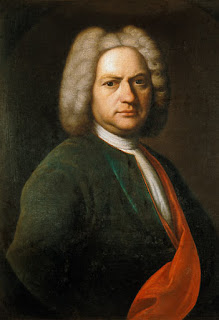 |
| Einav Yarden recording at Rolling Hills United Methodist Church on March 11, 2022. |
REVIEW
Einav Yarden, Second Sundays at Two, Rolling Hills United Methodist Church
DAVID J BROWN
 |
| Einav Yarden. |
Thus it was an especial pleasure to be back in the spacious but analytical acoustic of Rolling Hills United Methodist Church for a recital by the Israel-born, Berlin-based pianist Einav Yarden that very much embraced the eternal verities. The centerpiece was the English Suite No. 2 in A minor BWV807 by J. S. Bach, one of the six in this set, which is generally, though not universally, thought to be the earliest of Bach’s groupings of keyboard suites, dating from his time in Weimar (1708-1717).
 |
| One of only three authentic portraits of J. S. Bach known to have survived, painted by Johann Jakob Ihle in 1720, a few years after the English Suites are thought to have been written. |
To the fourth movement Sarabande, which like all but the Prelude is in two halves both marked to be repeated, Bach adds a kind of supplement headed “Les agréments de la même Sarabande” (literally “the amenities of the same Sarabande”), and like many performers Ms. Yarden opted to play the respective agréments after each half of the movement in place of the literal repeats.
A finely calculated increase in emphatic joyousness infused in turn the two Bourrées I and II and the final Gigue, so that the entire performance had a cumulative wholeness that made the work emphatically more than the sum of its parts—not to mention a definitive answer to any lips-pursing or head-shaking about the need to play Bach only on instruments of his time.
 |
| Carl Philipp Emanuel Bach. |
After the Bach English Suite, she ended with five of Brahms’ seven Fantasien Op. 116, itself the first of four collections of piano pieces with consecutive opus numbers dating from 1892-93 that form an important element in the final phase of Brahms’ composing career. To quote the late Brahms authority Malcolm MacDonald: “Unlike these following groups, op. 116 seems less a compilation than a self-consistent entity,” and I regretted that time constraints (presumably) required the omission of the fourth and fifth pieces.
 |
| Brahms at a picnic. |
Having previously managed to attend only one of Ms. Yarden’s several previous appearances in Classical Crossroads’ series—a Beethoven/ Schumann recital almost six years ago—it was a great pleasure at last to hear this remarkable pianist perform live again on this side of the great Covid divide—and permanently thus enabled, we must fervently hope! This recital can be enjoyed on YouTube here.
---ooo---
"Second Sundays at Two," Rolling Hills United Methodist Church, Rolling Hills Estates, Sunday, March 13, 2022, 2.00 p.m. (recorded Friday, March 11).
Images: The recital: the author; Einav Yarden: artist website; J. S. Bach: MyArtPrints.com; C. P. E. Bach: Wikimedia Commons; Brahms: CMUSE.
If you found this review to be useful, interesting, or informative, please feel free to Buy Me A Coffee!













No comments:
Post a Comment